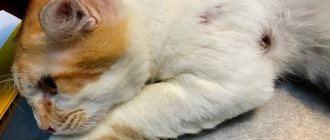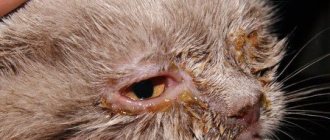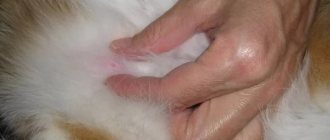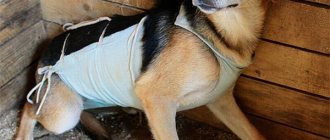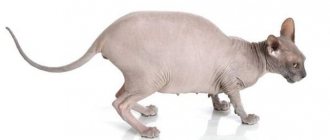Pyometra is considered one of the most dangerous pathologies of the reproductive system in cats. Moreover, an animal of any age is not immune from the development of the disease. Pyometra is not dangerous only for castrated cats whose genitals are completely removed. The absence or untimely treatment of such a pathology in an animal can lead to its death.
- 2 Causes of the disease
- 3 Symptoms of pathology
- 4 Diagnosis of the disease
- 5 Treatment of pyometra
5.1 Drug therapy
- 5.2 Surgery
What is pyometra
Pyometra is an inflammatory process that occurs inside the uterus and is accompanied by the accumulation of pus. In most cases, pathologies of the genital organs in animals are hormone-dependent. Estrogen and progesterone, acting in high doses on the endometrium each cycle, contribute to the production of mucus, which is a favorable environment for the proliferation of bacteria. Under natural conditions, such a process does not exist, so pyometra is a problem for domestic animals. A regular increase in hormonal levels without conception in pets leads to the appearance of cysts and the proliferation of pathogenic organisms in the uterine cavity.
Causes
“Anti-sex” hormones as a cause of pyometra
There can be more than a dozen causes of pyometra in a cat, but the most important are two:
- problematic childbirth with trauma to the uterus, when microbes easily penetrate from the outside and multiply quietly in conditions favorable to them;
- frequent and uncontrolled use of hormonal drugs that block sexual desire (estrus).
You should know it! Progesterone, which is most often included in anti-sex pills or injections, promotes the secretion of secretions by the epithelial cells of the uterus. The liquid, unable to find a way out, accumulates and begins to rot under the influence of microorganisms.
Other less common, but nevertheless important factors in the occurrence of inflammation include:
- transition of the inflammatory process from other organs (vagina, ovaries);
- prolonged or difficult labor with the fetus remaining inside,
- violation of the principles of sterility during obstetrics,
- infectious processes affecting the reproductive system,
- violation of feeding and living conditions of pregnant females.
Important! In a chronic animal with low resistance and a weak immune response, the risk of inflammation increases significantly.
Causes of the disease
The main reasons contributing to the development of pyometra include:
- hormonal disorders and decreased immunity;
- unsanitary conditions during the birth of kittens;
- taking medications to animals to prevent the onset of estrus;
- incompletely cured genitourinary pathologies;
- uncontrolled or mating with unexamined males.
It has been noted that the disease most often develops in animals that have given birth over the age of five years, and in nulliparous animals over the age of three years. Often, pyometra can be the result of complications after childbirth or termination of pregnancy, or injuries to the pelvic bones.
Pyometra in a cat - care in the postoperative period
A cat with a surgically removed pyometra needs special care at home. The speed of your pet’s recovery depends on how well medical instructions are followed during the postoperative period. When observing an animal, the following requirements must be observed:
- put a post-operative blanket on the cat so that the animal does not chew or lick the stitches;
- conduct daily inspection of the surgical suture;
- If inflammation or redness appears at the site of the suture, the animal should be shown to the attending physician.
Even though your cat may lose his appetite, he should always have clean water. In the postoperative period, you need to follow a dietary diet - soft or semi-liquid food (pate, chicken broth with chopped meat). If a cat's health deteriorates after the pyometra has been removed, it must be shown to a doctor.
Symptoms of pathology
Pyometra is characterized by rapid development. The first symptoms of the pathology become noticeable after about 4-6 weeks after estrus or immediately after delivery. Their nature and intensity are influenced by the form in which inflammation occurs.
When the cervix is open - the so-called open form, intense purulent discharge is observed, the cat pays great attention to the genitals, and brown spots can be seen in the places where it rests. The pet's temperature rises, she eats poorly, and drinks a lot.
The severity of the closed form of the pathology lies in the fact that pus collects in the uterine cavity. In just a few days, the volume of pus can increase greatly, which will lead to stretching of the walls of the uterus and subsequent rupture of the organ. Once in the abdominal cavity, purulent masses cause peritonitis and sepsis, which inevitably leads to the death of the animal.
With pyometra, due to accumulations of pus in the cavity and horns of the uterus, the organ significantly increases in size
For a more severe, i.e. closed, form of pathology, the following symptoms are characteristic:
- bloating and abdominal pain;
- drowsiness, low mobility and apathy;
- temperature increase;
- refusal of food;
- strong thirst;
- frequent urination.
Inflammation can also begin while the cat is pregnant. In such a situation, it is impossible to save the kittens, but there is a chance to cure the animal itself.
How does the disease manifest itself?
The first symptoms of pyometra in a cat begin with general malaise:
- the animal is constantly lying down
- eats practically nothing
- drinks a lot of water, which may be associated with a rise in body temperature,
- before our eyes he is losing weight and weakening,
- the coat becomes disheveled and dull.
A cat licks vaginal discharge.
Specific signs of pyometra in a cat include:
- enlargement of the abdomen, sometimes the female becomes like a bloated barrel;
- abundant purulent discharge from the vaginal loop, it smells bad, the consistency resembles cream, and has a dirty milky color;
- The discharge is not constant: it either stops or resumes.
Important! A long course of the disease provokes the formation of a cancerous tumor, so treatment of pyometra in a cat cannot be delayed.
Diagnosis of the disease
If you suspect a pathological process in the uterus of an animal, you must immediately contact a specialist. The pet is prescribed an ultrasound, during which the doctor examines the condition of the diseased organ - as pathology develops, the size of the uterus increases significantly, its walls thicken, and cysts are visible on the surface. The animal's blood is also analyzed. With pyometra, increased urea, leukocytosis, and hyperglobulinemia are observed. Protein is found in the urine.
If the development of pyometra is suspected, the animal is subjected to ultrasound examination.
Signs and symptoms
The nature of the manifestation, symptoms and treatment of pyometra in cats largely depend on whether the animal’s cervix is dilated. When the canal is open, purulent fluid flows out through the vagina, so its traces are found on the animal’s fur, on furniture, carpet, bedding, if the cat was lying in these places.
Detection of this sign is often complicated by the pet’s increased cleanliness. In this case, the cat constantly cleans out pus accumulations, which prevents them from being seen under her tail or on household items.
Other manifestations of the disease that an attentive owner can notice are:
- poor appetite;
- constant thirst;
- elevated body temperature (but not always, but from time to time);
- fatigue, decreased activity, drowsiness.
Poor appetite
If the discharge contains blood clots, this indicates a very severe course of the disease.
It is important to remember that an open cervix can close at any moment, and then there will be a direct threat to life. In this case, the symptoms presented above intensify many times over. The pus that collects in the uterus puts pressure on surrounding tissues and stretches the abdomen. At this time, bacteria produce substances harmful to the body, which are absorbed into the blood and have a depressing effect on the pet. Toxins cause poisoning in the animal, which is accompanied by nausea, vomiting and diarrhea.
The waste products of bacteria affect the functioning of the kidneys, as a result of which the process of urine formation becomes more intense. To compensate for the lack of fluid, the cat begins to drink more. This symptom occurs regardless of whether the cervix is closed or open.
Treatment of pyometra
If a cat is diagnosed with pyometra, drug therapy may be prescribed, but a more effective way to get rid of the problem is surgery.
The advantage of conservative therapy is that the animal retains the ability to bear offspring.
Drug therapy
Medicines can only help with the open form of the pathology, and even then not always. With this treatment there is a risk of relapse. Complex therapy for inflammation is aimed at removing purulent masses, getting rid of bacteria and increasing the body's resistance. Experts prescribe the following categories of drugs:
- Hormonal. Oxytocin or Prostaglandin are usually used - they cause the uterus to contract, which helps remove pus.
- Antibiotics. Brulamycin, Amoxicillin, Cloprostenol to get rid of pathogenic microflora.
- To enhance immunity. A specialist may prescribe Immunofan or Ribotan as immunomodulators.
If there are no positive changes, the doctor should insist on surgery.
Surgery
The surgical method, which involves removing the uterus and ovaries, is considered the most effective for ridding an animal of pyometra. The operation is performed under general anesthesia and if assistance is provided in a timely manner, the likelihood of a complete recovery is very high. In the case of a closed form of pathology, specialists, in most cases, immediately prescribe surgery.
Removing the uterus and ovaries is an effective way to get rid of pyometra
If the owner did not purchase the animal for breeding, then it is better to castrate it. This is the best measure to prevent the development of pyometra.
Comments
Continue to call your primary care physician if you haven't already.
We recommend reading: What Ear Mites Look Like in Cats - Are They Dangerous for Humans?
If you can’t get through by phone, I would advise you to syringe the vagina with a small volume of dioxidine (2-5 ml) and take a general clinical blood test.
There are some subtleties with douching. In particular, in no case should the jet be directed deep into the vagina (so as not to drive the “infection” into the cervix with the jet), but should be directed upward so that everything flows out along the vaginal vault.
It may be worth taking a vaginal smear for cytology (if there are a lot of leukocytes there, it means inflammation is occurring).
If you can’t get through by phone, I would advise you to syringe the vagina with a small volume of dioxidine (2-5 ml) and take a general clinical blood test.
The main signs of complications after sterilization are:
- if the suture bleeds after surgery (do not confuse it with ichor)
- if urination is bloody and has an uncharacteristic color
- if a cat does not go to the toilet for 3 days after sterilization
- if the temperature continues to stay at 39.5 C on day 5
- if the pet turns out to eat food for more than 5 days
- if your cat has diarrhea or constipation after sterilization
- if after 5 days, the postoperative suture remains wet, swollen, red, signs of rotting appear, or the discrepancy is more than 1 mm
- if there is discharge from the loop (vagina) of the cat
- if the pet is lethargic all the time, does not react to anything and sleeps a lot
- if the animal behaves restlessly and screams
If any of the signs are detected, you should seek help from a qualified specialist.
Some cat owners mention that after sterilization their cat became aggressive for a while. This is most likely due to pain felt at the incision site. In this case, painkillers prescribed on the recommendation of a veterinarian should help. Another reason for the cat’s increased aggressiveness may be a failure of the hormonal system that occurred after the removal of the organs responsible for the production of sex hormones. Although the situation seems to be developing in the opposite direction, such a scenario is also not excluded.
First, the animal must be examined by a doctor and prescribed a set of necessary diagnostic measures. Depending on the suspected disease, the following studies may be prescribed (variably or in combination): blood tests (simple, detailed, biochemical) and urine, cultures to identify the bacteria that cause the infection, vaginoscopy, X-ray or ultrasound, biopsy with cytology, serological studies.
The choice of treatment method depends on the specifics of the disease. Some can be resolved through therapeutic measures, others only through surgery. So, if the appearance of vaginal discharge is associated with pathological processes, therapeutic measures are prescribed. In cases of serious infectious diseases, tumor formation, inflammation and damage to the genital organs, surgical operations may be prescribed. The following methods are carried out:
- in case of blood clotting disorders (mechanical injuries, postpartum complications) - hemostatic therapy;
- the use of antibiotics - to suppress pathogenic microflora;
- removal of the uterus and its cervix, possible removal with appendages;
- removal of tumors. It is also possible to remove benign formations. Removal of malignant tumors is also accompanied by drug treatment.
It is important to remember that in any case it is better to seek advice from a veterinarian.
Caring for an animal after surgery
Competent postoperative care for the animal is very important to prevent the development of complications and the speedy restoration of normal functioning. The pet owner must:
- for the first time after surgery, to prevent the animal from licking the stitches, dress it in a blanket;
- regularly inspect the stitches and if redness and inflammation appear, immediately visit a veterinarian;
- feed the cat liquid and semi-liquid foods, do not forget about a sufficient amount of water in the bowl.
If you suspect a deterioration in your pet's condition, you should not postpone a visit to the doctor.
Some information about the operation
Of course, the process of sterilization itself, that is, removal of reproductive organs, is not necessary for ordinary people to know. It is important to understand that such an operation is necessary if you do not want to breed kittens.
We recommend reading: Brain swelling from 40% glucose in a dog
There are two types of cat sterilization:
- ovariohysterectomy : during the operation, all reproductive organs (ovaries and uterus) are removed;
- oophorectomy: the most common method, which involves removing only the ovaries. This type of sterilization is somewhat more dangerous than the previous one, since the non-functioning uterus remaining in the abdominal cavity can become inflamed and cause a new operation.
Veterinarians also use different methods for sterilizing cats, depending on the skill of the doctor, equipment and cost of the procedure:
- A classic option that has been successfully used for many years. The veterinarian makes an incision along the linea alba and removes the reproductive organs. The advantages of this method include its relative ease of execution, low cost of the operation, and the disadvantages are quite large, compared to others, damage to the body.
- Safer is sterilization using a side incision, which is much smaller than the classic one and causes less damage to the body. The abdominal muscles are dissected (that is, pulled apart and clamped with a blunt instrument) rather than cut with a scalpel.
- The most advanced and most expensive method of sterilization is laparoscopy. A small puncture is made in the abdominal wall through which the device is inserted. The uterus and ovaries are safely removed through electronic monitoring. There are practically no stitches, and the animal does not require postoperative care.
When taking your pet home after surgery, place it in a carrier with soft, warm towels. The animal's body temperature may drop slightly.
Prevention of pyometra
You can be sure that the cat is insured against the development of pathological processes in the uterus only if it is castrated. If the animal is used for breeding, then this measure is undesirable for the owner. Those who want to preserve the reproductive function of their pet will have to adhere to certain rules and work hard, namely:
- do not use hormonal drugs to suppress heat;
- Perform ultrasounds regularly;
- carry out matings only with carefully examined males;
- provide sterile conditions for the birth of offspring;
- take care of prompt veterinary care in case of excessively long or pathological lambing;
- Monitor discharge from the cat’s genitals and, if present, immediately contact a specialist.
Sometimes, to prevent the development of pyometra, specialists prescribe antibacterial and hormonal agents.
Symptoms of hematuria
The cat's discharge should be transparent and have a yellow-orange tint. If the owner finds blood in the cat’s urine, this indicates an inflammatory process or other problems in the animal’s body that need to be eliminated. First of all, it is necessary to find out why there was blood in his urine, and then begin treatment.
In order to be able to control the color of the cat’s excrement, it is worth teaching him to pee on an empty tray or choose a light-colored litter. Pink, brown or red urine with possible blood clots indicates problems with the animal's health. Deep-colored urine results from an excess of red blood cells, which indicates inflammation in the body.
In addition to the fact that there is blood in the cat’s urine, hematuria may have the following symptoms:
- lack of appetite;
- lethargy and apathy;
- increased body temperature;
- the animal urinates past the tray onto furniture and carpeting;
- When a cat pees, nervousness is observed in its behavior as a result of painful urination.
Red urine may be the result of your cat eating carrots or beets. In this case, you don't need to do anything. The most reliable method for determining the presence of blood in urine is a laboratory test for red blood cells.
Collecting urine for analysis
Red discharge in cats indicates serious illnesses that may require long-term treatment. The first thing the animal owner needs to do in this situation is to collect urine for analysis. After this, you need to show the cat to the veterinarian, and send the finished material for research. For laboratory tests, urine collected no earlier than 3-4 hours ago is suitable.
- The tray must first be rinsed with hot water;
- The filler is either removed altogether, or small sea pebbles are placed at the bottom of the pot;
- The finished urine is poured into a clean container and submitted for analysis no later than 4 hours after collection;
- The animal must be fed no later than 6 hours before the test is taken.
We recommend reading: Weeping Ringworm in Cats Photos

